Today is the final day of Easter, and I thought I'd like to put up a couple of things that I've enjoyed puzzling with in the kitchen over the weekend.
Worth waiting for, part 1
Pasta is one of those things that I love making during weekends. There's something about weighing up flour, heaping it up on the work surface and making a little mound in the middle for some eggs and a dash of olive oil, that just feels right. Like bread, the basic ingredients are so simple, but the variations are virtually endless. A little over a year ago, I bought an Atlas 150 pasta machine that I'm happy to say has been in use on an almost weekly basis since then. Fresh pasta - delicious and fun to make – what's not to like?
I had my sister over for dinner on Saturday, and wanted to prepare a light pasta dish as our first course. This time I settled on some raviolis (perhaps tortellini or cappeletti is a more accurate name for the final shape of these?), filled with homemade ricotta and spinach.
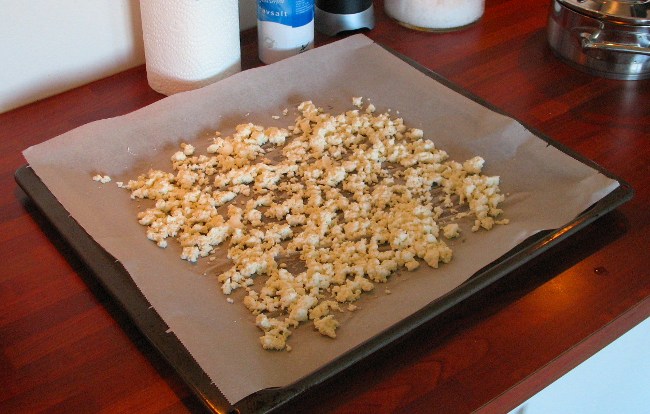
I find that the main advantage of making one's own ricotta (apart from the satisfaction of making it from scratch, of course), is that the cheese has a much smoother mouthfeel than the otherwise coarse and crumbly industrial product. It keeps in the fridge, well covered, for up to 2 weeks, so it's worthwhile to make a fair batch while you're first at it.
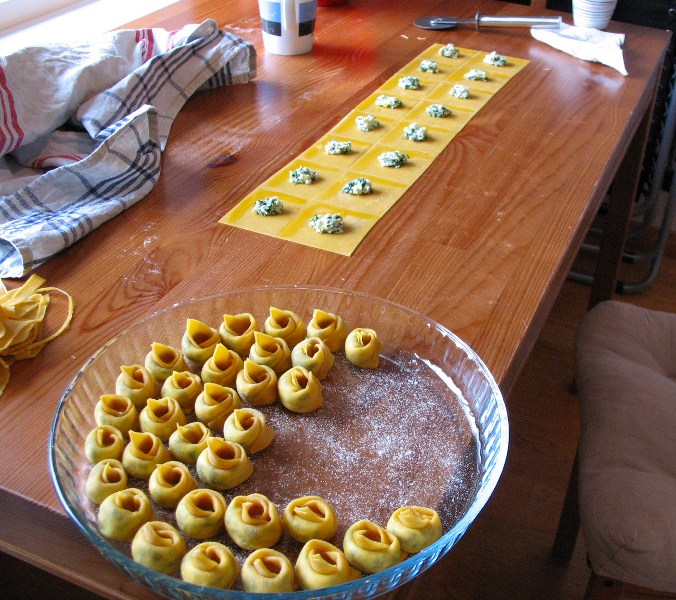
Filling and shaping these rascals take time, so setting out making these on a busy week night is not something I would recommend! They're perfect for a lazy weekend afternoon, accompanied by good background music and a glass of crisp white wine.
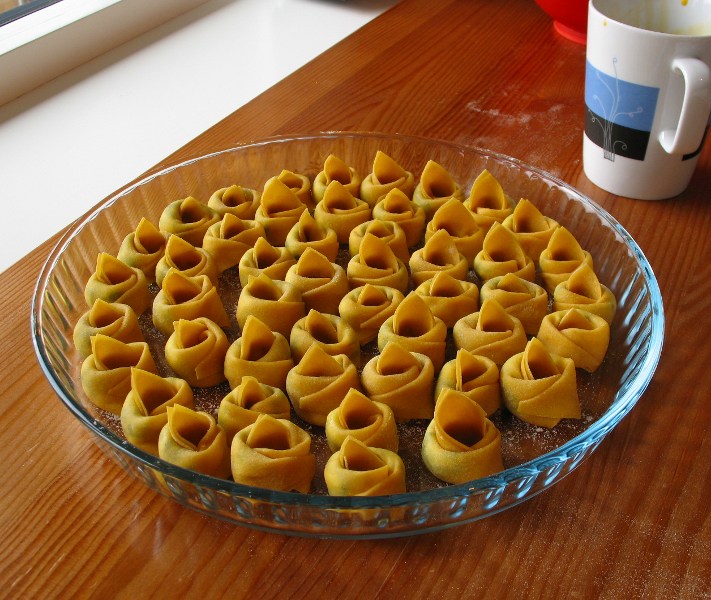
There! An Italian grandmother would probably not fully approve... but hey, at least they look handmade... there's something to be said about the «rustic» quality of that though, right?
Anyways, both me and my sister enjoyed these as our first course – here accompanied by some greens, cherry tomatoes, more ricotta, a dash good olive oil and a grinding of pepper.
Worth waiting for, part 2
I'm very, very fond of salted, dried cod (clipfish), and that's what I planned for our main course on Saturday. Spanish fishermen fishing cod at Newfoundland were the first to salt and dry their catch, and this was a method of conservation they started sometime during the 16th century. The practice of salting and drying cod was brought to Norway by the Dutch Jappe Ippes in the 1690s, and the method was further established in this country by some Scots in the early 1700s. Since then, particularly Kristiansund, a town on the Western coast of Norway, has been known for excellent salted, dried cod.
As the availability of fresh fish increased, Norwegians looked upon salted and dried cod as a «poor man's fish», and most of the conserved fish was (and is) exported to Spain, Portugal, France, Brazil and other Latin American countries. Export of salted, dried cod (and also un-salted, dried cod) is still a large industry, but thankfully, with the help of popular gourmet chefs, this product has been re-discovered by more and more Norwegians over the last decade. Now, a wide range of salted and dried cod products can be found in most well-stocked grocery stores; from the cheaper tail end pieces suited for casseroles, to highly expensive, gracefully aged loin pieces, comparable to some of the finest cured sausages.
For our dinner, I chose some mid-range loin cuts that are well suited for grilling, pan frying and baking. The cod needs to be reconstituted in several changes of cold, fresh water before they can be cooked; this re-hydrates the meat and extracts some of the salt from it. Soaking can take anything from half a day for the thinnest pieces to more than 4 days (and 4 – 5 changes of water) for the thicker, neck pieces from the fish. Ours took roughly 2.5 days and 3 changes of water to be ready.
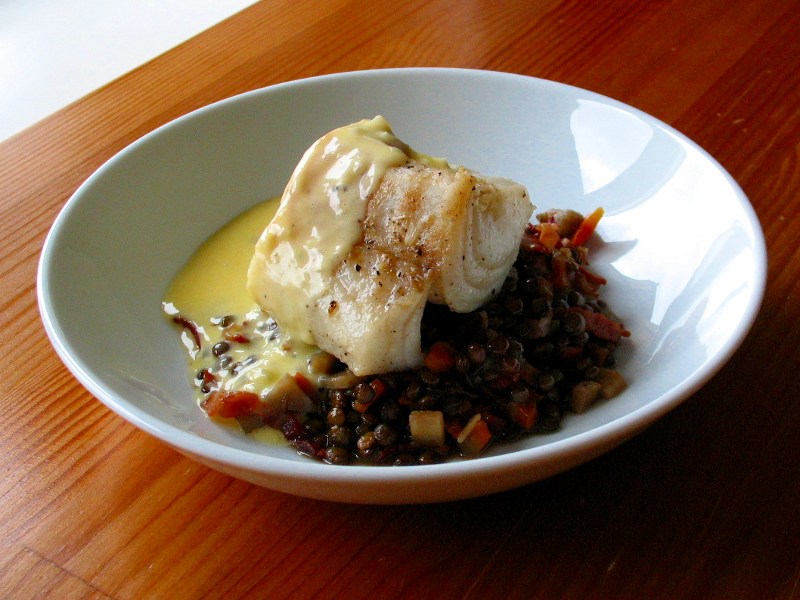
We enjoyed the fish on a bed of Puy lentils and root vegetables, thin slices of salted pork belly and Nantais butter sauce (begin by simmering shallots and white wine in a sauce pan, as for a beurre blanc, add a dollop of crème fraîche after 5 mins, continue to simmer until slightly thickened, then beat in cubes of butter over low heat, whisking vigorously, taste for salt and pepper).
Worth waiting for, part 3
Well, yes, there needs to be a loaf up here as well... Equally inspired by a Hamelman formula and David's wonderful walnut and raisin sourdough loaves that he told us about recently, I felt a craving for bread with walnuts in it. I came up with a formula rather similar to the one in "Bread" for a sourdough rye with walnuts, but with slightly less walnuts, some whole-wheat flour in there and a higher hydration.
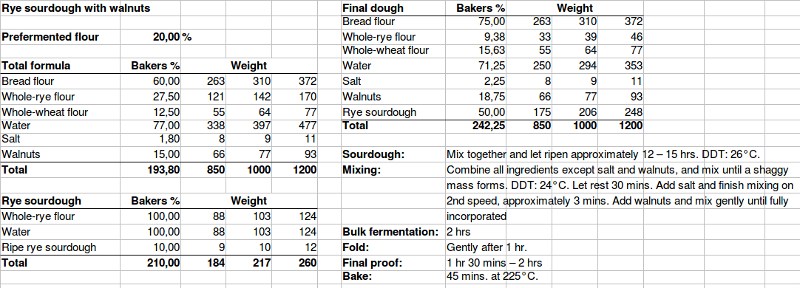
I wanted to focus on the flavour of a nicely ripened rye sourdough, the flour composition and the walnuts, so the recipe and formula itself is rather minimalistic and straight forward. It was the first time I tried it this morning, so it's not fully optimised yet, but I still feel it came out well-balanced hydration wise and in terms of bulk fermentation time and the final proof. It could hopefully serve as a decent baseline if anyone would like to bake a similar bread.
Below is a photo of the dough after bulk fermentation, just prior to pre-shaping. As the bulk fermentation was roughly 2 hours, I feel that a (very) gentle fold is required midway through. This strengthens the dough significantly, and makes it much more responsive and easier to shape afterwards.
If your time runs out, or if you're baking on a week night, you could probably retard it immediately after final shaping, but I think I would reduce the amount of pre-fermented flour somewhat if you're heading that route. I proofed and baked the loaf without any retardation; in that case, a final proof of approx. 1hr 45mins was right for me. It will definitely depend on your ambient temperature and the vigour of your sourdough, so start poking gently after some 70 - 80 mins.
Here's a shot of the loaf, directly from the oven:
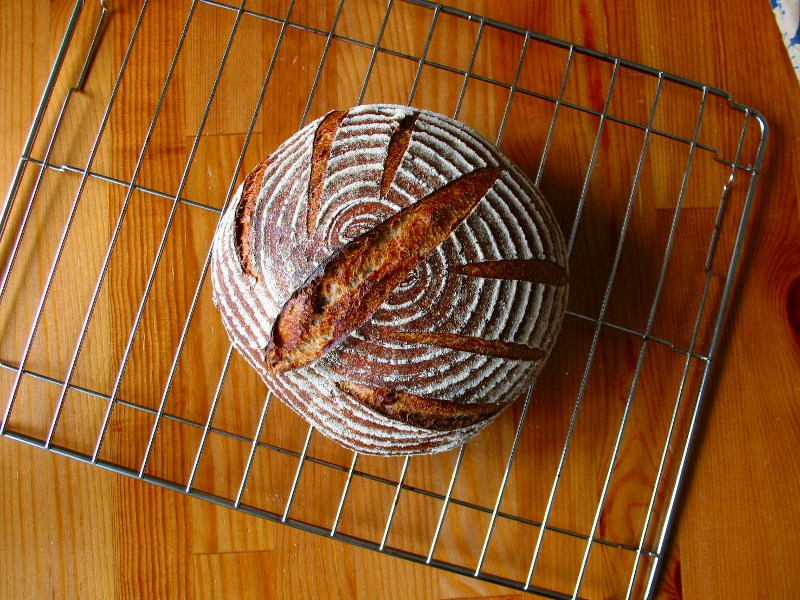
It had a nice, singing crust as it cooled down, and filled the kitchen with a most lovely smell. The singing crust and smell of the baked loaf is one nice perk of baking at home... And the crumb:
This will keep me happy the coming days, I expect!
I hope everyone enjoyed their Easter, and that you were able to spend it with friends, family and your loved ones. The days around Easter are always welcome as a respite from hectic weeks on either side of the celebration, and one can find a bit of peace and time for reflection.
I'm set for more time off in a few days, as I'll be taking my vacation early this year. I'm flying to Kiev on Friday, and I'll be spending three weeks travelling around in Ukraine, a country that has fascinated me for a long time with its rich culture and proud (but also, at times, tragic) history. I won't be freshloafin' much during those weeks, but I will make sure to sample Ukraine's range of baked goodies while I'm there. Hopefully, I'll have some photos to share in my next blog post. Until then, au revoir!
- hansjoakim's Blog
- Log in or register to post comments
The ravioli look perfect and that cod 'to die for'.
That line had me slobbering all over the keyboard. Unfortunately the bread pics aren't downloading for me. Not the first two, anyway. I can only see the pic of the cut loaf, however, it does look fantastic.
How do you make homemade ricotta? That sounds intriguing.
Best,
Syd
I made Croquetas de Bacalao on Saturday and, after eating them, wondered why I even used salt cod, which didn't stand up to being fried in olive oil. (It took two days of soaking for me too).
I'll just use fresh or frozen cod next time and use the salt cod to make your dish, which is just beautiful–and everything is better with lentils.
Photo credit. Kime, Tom. "Southern Europe - Spain." Street Food: Exploring the World's Most Authentic Tastes. New York: DK, 2007. 130-31. Print.
Oops! That's not my photo. I updated the post with a photo credit.
That was exactly the problem with my croqueatas: the other flavours, particularly the olive oil and the smoked paprika, overwhelmed the cod such that I had no impression of it whatsoever. Croquetas de Paprika or Paprika Latkes would have been a more apt title. Next time I'll use a neutral oil and 1/4 the recommended paprika.
Thanks for that ricotta recipe hansjoakim. I will most certainly give it a try. And, yes, this morning I can see all the pics. The bread is stunning and I love that scoring pattern.
All the best,
Syd
One exclamation for each scrumptious item! Really Hans, all just superb.
BTW, I doubt any Italian grandmother would scoff at your pasta shaping skills - and we both know that's a high compliment indeed!
Love the accompaniments to the cod. Drooling (mentally!) at the thought of that combination.
Your pics and description of the walnut bread has elevated your recipe to the top of my pile. I haven't done a walnut SD for ages, and can't wait to try it. One quick question, pls: you only do one gentle fold, 1 hour into the bulk proof - correct? I think I may need to do more than that, since I only handmix.
Cheers!
Ross
Ross,
I will pipe in here to since I did this loaf last week inspired by David's bake. I did an auto. as Hans did and then a very short mix in my DLX to incorporate the rest of the ingredients only. The rest was S&F's and I did about 3 @ 45min apart. You will feel the dough getting stronger each time. I just kept going until I had the strength I wanted BUT I also retarded the dough overnight in the refrigerator and the following morning it was even stronger and way easier to handle. I also use 100% whole grains which makes a difference in how doughs handle.
It is a very tasty combination of ingredients. I also upped the raisin amount as I have a daughter that LOVES lots of fruit in breads making them almost a meal in themselves.
You will really enjoy this one :-)
Take Care,
Janet
Your pasta shaping skills are pretty darn good, Hansjoakim. Those little things are quite tricky. Most people tend to overfill them. Very well done. The bread is beautiful too, of course.
and it's all your fault :) Your pasta looks wonderful, and I know how tasty homemade ricotta is, I bet they were great. And salt cod with lentils, butter and creme fraiche- yum! Walnut boule is pretty and looks divine. May I volunteer to take any leftovers off your hands as you head out of town?
Have a great trip!
Hello Hans,
There is so much here in your beautiful post – the food you prepare looks chef-worthy – oh, how might one acquire a reservation, for a seat at your table?! :^)
I tried making homemade ricotta for the first time a couple of weekends ago, to use for tart filling. What a tasty experience that was – I completely agree with you, much better than store-bought. It sounds like a great afternoon, having time to fill and shape the pretty pasta - your sister must have been so pleased and impressed!
I agree with Syd about your fish dish – stunning :^)
Your walnut bread is, of course, beautiful. I hope you have a wonderful trip to the Ukraine and get to experience many of the regional baking specialties.
:^) breadsong
Wonderful! Would you mind if I tossed this up on the home page for a bit?
-Floyd
Thanks so much, Floyd! I hope you had a wonderful Easter.
I would be honoured to have the post on the front page.
done Hans. Love your Easter feast with 'torteoli' home made ricotta , salad, salt cod and lovely bread. Sounds wonderful!
Beautiful looking and I'm sure tasting pasta. Your fish and walnut bread look amazing as well.
Thanks for sharing your recipes.
Ian
Hi Hans,
Love your Easter foods and the raisin walnut loaf. I just made that one too and my daughter immediately had me place it on her 'favorites' list :-) She usually prefers cranberries but I continue to sneak other fruits in now and then and she is always surprised. I ended up putting more raisins in ours because she LOVES tons of fruit.....a very sweet tooth doth she possess - or maybe it possess her....anyway, glad you like the loaf too. It is a keeper.
Your holiday plans sound wonderful. I always love it when TFLers take a holiday because I can then see where they went when they get back so it is kinda like being there too......a loooong stretch of my imagination :-)
Have a wonderful trip and enjoy your self!
Take Care,
Janet
P.S.
I just made some cheese this past weekend too but mine was cream cheese - not ricotta. Is making ricotta similar? I have never attempted that but cream cheese is a snap to make ( starter added to some cream and then left at room temp. for about 12 hours and then hung up in cheesecloth to drain for another 12 hours....) and then today I made a batch of Whey, Honey and Butter bread (Recipe out of Dan Leopard's 'The Handmade Loaf')with the whey from the cheese. Wonderful texture to work with and incredible oven spring. Nothing beats fresh ingredients....nothing!
Thanks so much for your generous and kind replies, everyone!
FlourChild: Most certainly! ;-) I'll leave a pair of keys underneath some small decorative rocks on the right hand side of the entrance - no way you'll miss them. Sneak in and fill up. Just remember to put used dishes in the dishwasher before leaving :-)
breadsong: Thanks again so much for your kind comment! This one-man operation has not gone global yet, I'm afraid... ;-) I'm glad you enjoyed your ricotta tart! I'm always looking for more ways to enjoy the cheese, so I'm wondering whether it was a baked tart, or a pre-baked tart shell filled with ricotta? Did you mix the ricotta with something else (egg yolks and/or pastry cream), or did you use it plain?
Janet: Thanks! I posted the recipe I used for ricotta in my reply to Syd, a little above. I've never made cream cheese before, so that sounds intriguing. Thanks for the tip! Is that something one could use for instance in a cheesecake, or would the cream cheese separate, you think? Thanks again!
Hi Hans,
You're welcome, and thank you, truly. Your skill, pictures and menus are outstanding!
The tart shell was pre-baked and the tart baked again once filled, and was an experiment/mixture of things - taking inspiration from (3) recipes (a torta di ricotta recipe from The Vegetarian Epicure by Anna Thomas, a recipe for Torta Ricotta in Mr. Friberg's book The Professional Pastry Chef, and Rose Levy Beranbaum's Apricot Cheesecake Tart).
I ended up with something I called 'torta di apricotta' :^), using 50% soft whole wheat flour and some apricot brandy in the pastry, blind-baked and moisture-proofed with egg white as Rose recommends (worked like a charm to preserve crispness in the pastry after the second bake with filling); the filling was 100% fresh ricotta, 89% pastry cream flavored with orange brandy and orange zest, 8% whole egg, 6% egg yolk, 8% sugar, 1% pure vanilla, and more orange zest...and apricot brandy-soaked dried apricots.
I didn't use any cream cheese, not having any on hand when I was making this.
The filling set up nicely (relief!) and I was very happy with the crispness of the crust when it was finished baking (the moisture content of the filling was a concern but it turned out OK). I loved this filling, combining the fresh ricotta and pastry cream.
You make the most beautiful tarts - it will be lovely to see a ricotta tart, if you decide to make one!
:^) breadsong
Thanks for your input, breadsong!
I've wanted to make the Torta Ricotta from Friberg's book for some time now, but never really got round to it. Your take on the tart sounds lovely; probably a keeper that stays moist for days.
You're right about the crispness of the shell - to me, that's crucial to a great tart as it contrasts the soft filling. Thanks for the tip about egg whites - sounds like a great way to preserve crispness.
Hi Hans,
Thank you! - the filling had good moisture and a nice balance of flavors, not too sweet.
Rose's tip for the crust is a good one; she recommends, after the tart shell is baked, to cool it for about 3 minutes on a cooling rack, then brushing with a thin coating of egg white (if the egg is applied while the tart shell is too hot, the egg white will just flake off).
(Other moisture-proofers for crust Rose writes about are seedless raspberry jam, sieved apricot preserves, chocolate or couverture chocolate, white chocolate, even melted cocoa butter or clarified butter (at room temperature); if using chocolate or butter, allow to sit until set / refrigerate for a short time.)
Hope this isn't too much info - but these other options sounded so nice for adding flavor/complementing other flavors in pies or tarts!
:^) breadsong
Hans,
Thanks for pointing out the recipe. I don't always read through all the responses so I miss things.
Seems easy enough to do. I like your recipe as it uses lemon juice instead of one I read that uses vinegar. Guess that as long as it is an acidic ingredient it will curdle the milk. I had never made cheese before and was surprised by how easy the cream cheese was - no heating of anything. Only draw back was that I had to purchase a starter from New England Cheese Making Company (http://www.cheesemaking.com/cheeseculturesandmoldpowders.html) to make it. A basic mesophilic starter which you can probably get too. Not sure if using something like yogurt would work as a starter or not.
Yes, it would work in a cheese cake. To make it thicker you simply leave it draining in the cheesecloth longer. It then firms up even more once refrigerated. While soft you can add herbs and spices for a cheese spread for breads or honey for a spread on bagels - which is how my son likes it.
Here is a link to the blog where I found the recipe. I liked it because it included pictures of how things should look :-)
http://chickensintheroad.com/cooking/homemade-cream-cheese-so-easy-a-child-could-make-it/
Take Care,
Janet
Beautiful presentation and photos!
Looking forward to your reports from the Ukraine.
David
Thanks so much, David!
I hope you had a nice Easter and enjoyed your trip to Death Valley.
Hans Joakim, every time I open your blog I can't avoid to admire your skill.
The bread is superb, nothing less. Did the crust came out crackly as in the good old times?
The cappelletti you made would make every grandmother disapprove only one minor detail: the tails should be folded with the rest, not pointing upward.
Your recipe for ricotta sounds very promising. Every time I tried to make my own ricotta at home using one tablespoon or two of lemon juice for litre of milk the result came out disgusting. I'll try your method.
@Nico: Thanks! **phew** I'm happy to hear that :) So the tip, now pointing up, should be folded back and down? And yes, I'm happy to say that the crust is back as it was before I moved. I'm now baking at a lower temperature (225dC the entire bake) for slightly longer (40 - 45 mins for a 800 gr loaf, up to 50 mins for a 1 kg loaf); this removes some of the excess moisture from the crumb during the bake, and the crust does not go soft once the bread is cool. The crust is so essential to a sourdough loaf, so I'm very happy to have resolved the issue. Thanks again, Nico! @Carl: Thanks, Carl! The bones were already removed, so it's simply a matter of soaking the fish. As for the lentils, I like to prepare them almost like a risotto: Heat olive oil in a large casserole, add vegetables (shallots, celeriac, carrots, garlic etc.) and sweat a few minutes, add lentils, stir and cook a few minutes more. Add a splash of wine and simmer a few minutes to boil off the alcohol. Add some stock (preferably homemade stock, of course!), and simmer until the lentils are cooked (not mushy, but with some bite) - roughly 10 - 15 mins. Lentils don't taste that much on their own, but I find that they easily soak up taste and flavour while they simmer - it's definitely worthwhile to use a flavourful stock.
as a 2nd cook of the milk after making yogurt. Yogurt is made by heating milk to 185 F, then rapidly cooling it to 115, stir in 3 T of yogurt per quart of milk used and keep heated at 110 F for 12 hours. Drain off the whey by placing the yogurt in a colander lined with paper towel. After 4 hrs in eh fridge you have Greek yogurt and the whey required for ricotta. Reheat the whey to 210 F and add a little lemon juice. Skim off the ricotta curds and press in a basket until desired texture and firmness is achieved.
Yes, I think I've read somewhere that in Italy, ricotta is usually made from the whey left over after making mozarella and Romano. I love yoghurt, so I'm going to give your instructions a go next time. Thanks for the tip, dabrownman!
Do you have one of those fancy dough incubators? How are you keeping the temp. at 110 degrees for 12 hours? I'm sure knowing you DA you have some MacGyver contraption to achieve this :).
a wood cutting board down with a heating pad set to medium, covered with 1 or folded kitchen towels Depending on summer or winter). On that I put my temperature probe and cover it with the covered pot and the who shebang is covered with a folded thick beach towel.
I have bloogged about how to make yogurt 'to make your muffins taste bettah' with fancy do pictures and everything. It can be found here:
http://www.thefreshloaf.com/node/27297/how-make-yogurt-so-your-muffins-tastes-betta
dabrownman,
I will have to give this a try next batch of yogurt I make. I have been getting fresh goat milk and it makes a wonderful yogurt but I hadn't tried draining it to get it firmer. Will give that a go and see what happens next batch especially since goat yougurt tends to be a lot runnier than 'cow' yogurt. :-)
Thanks for posting this.
Take Care,
Janet
jealous of you!! We love to make goat cheese but struggle to find a fresh supply that isn't already spoken for or you need a tanker truck to haul it away. Never made goatyo, or gogurt, but I will :-)
I also love to make goat ice cream - totally in heaven just thinking about it.
This post is so full of delights, hansjoakim! Everything you put on the table looked masterfully and lovingly prepared. Your sister is a fortunate one!
That bread is gorgeous!!
I'm going to give your ricotta recipe a try, as well as the one dabrownman described. I make homemade ricotta (and love it dearly), but do it a bit differently. Another use for ricotta is cannolis, which I just made for Easter. http://www.thefreshloaf.com/node/28186/cannolis-easter
An added treat was to see breadsong's comments on the ricotta tart from The Vegetarian Epicure, which she and I had talked about. This post is so full of great information, it will take me a while to sort through it -- a task I look forward to!
Happy travels to you, and thank you for this wonderful, sumptuous post.
All the best
Janie
Hi hansjoakim,
Thank you so much for your comment about the cannolis! I've read that some people use wooden dowels to wrap the dough squares around, but I have to say that seems strangely foolhardy to me. You could burn the house down, potentially!! First of all, the tube would be very narrow unless you used a good thick dowel. My metal tubes are a shade under an inch in diameter and six inches long (U.S. measurements). Maybe someone with a better grasp of the physics of the hot oil + the wood could vouch for its safety. Not sure about flavor transference with the wood, either. Seems a lot of drawbacks to that method.
I can't think of another substitute for the tube shape, but what you could do is roll the dough out to the required thinness and then just cut shapes -- circles, squares, rectangular strips, whatever you felt like -- and deep fry them, then serve them with the filling piled on top. Last night my husband and I split what remained of the filling and used it almost as a "dip" for our extra deep-fried rectangles. Kind of like chips and dip. Not quite as elegant, but it was fantastic! Same flavor, different shape.
If you come across a good kitchen shop or bakery supply, the tubes will probably be fairly easy to find, though, if you want to have the traditional shape. They're very inexpensive. I've had mine for years and forget where I got them. I hope you give them a try . . . yours would be stellar, I'm sure!
Janie
As usual, Hans, you inspire us once more with Fresh made pasta, cooking and bread. Your love for Gourmet cooking, and baking is contagious :)
so, you bumped up the wholegrain flours to 40%! lovely!
As to your Vacation, i hope you enjoy every moment in Kieve and Ukrain. Do post some pictures when you return :)
Thanks so much for sharing!! I'll try all 3 (if I can source the salt cod!)
Also a really great description of the process for all, and the ideas, and the blending of flavours - so much that I want to try
Hope you have an amazing holiday